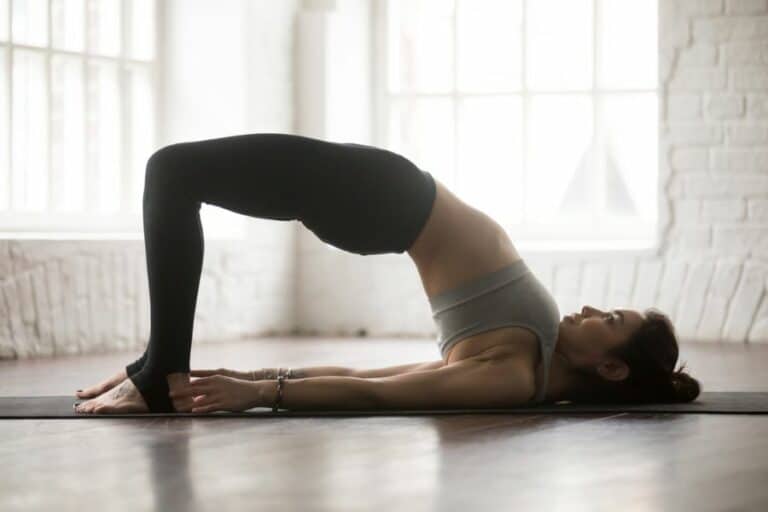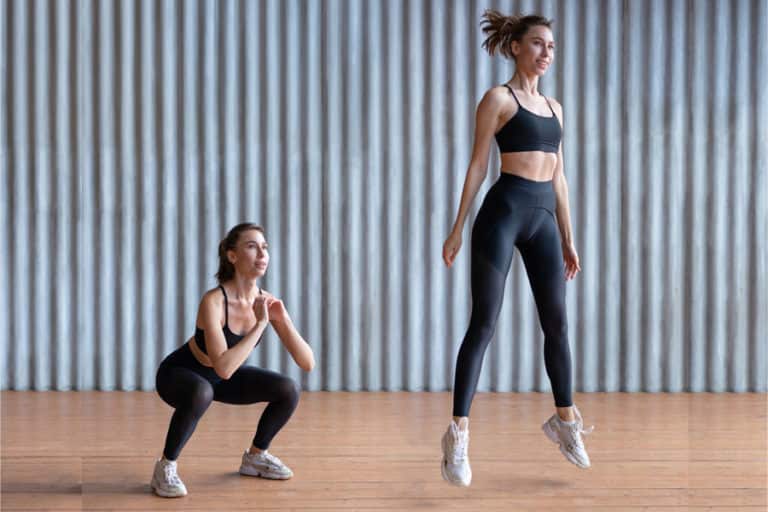Kas Glute Bridge: Benefits, Variations, Tips

How to do | Muscles Worked | Benefits | Mistakes And Tips | Variations | Comparison | Add to your routine
Strong glutes are crucial for activities that demand lower body strength, like running, jumping, and walking.
While squats and lunges can work the glutes, they involve other muscle groups like the quads and hamstrings. For those who want to focus on the glutes, the isolated Kas Glute Bridge is an effective way to strengthen this muscle group.
How to do the Kas glute bridge exercise?
The Kas glute bridge, popularized by Kaseem Hanson, is often mistaken for the glute bridge, but it actually functions more like a hip thrust. So, here is how to do it:
- Begin by placing a bench or sturdy elevated surface behind you. Sit on the floor in front of it with your knees bent and feet flat on the floor.
- Place a barbell in the crease of your hips and hold it with both hands. (If you want to increase the intensity)
- Lean back and rest your upper back and shoulder blades against the bench or elevated surface behind you.
- Your feet should still be flat on the floor, and your knees should be bent.
- Brace your core and engage your glutes, then lift your hips and barbell toward the ceiling until your body forms a straight line from your shoulders to your knees. Your knees should be bent at a 90-degree angle at this point.
- Hold this position for a few seconds, then slowly lower your hips and barbell back to the starting position.
- Repeat for the desired number of repetitions.
Kas glute bridge: muscles worked
The Kas glute bridge primarily targets the gluteus maximus, the largest muscle in the buttocks. However, it also targets other two gluteal muscles: the gluteus medius and minimus. The exercise also activates the core muscles and hamstrings but to a lesser degree.
Primary muscles worked
- Glutes: gluteus maximus, gluteus medius, and gluteus minimus
Secondary muscles activated
- Core muscles
- Hamstrings
Benefits of Kas glute bridge
Here is the list of benefits you can expect from Kas glute bridge:
1. Reduces the risk of momentum
According to a study [1]National Library of Medicine: A comprehensive biomechanical analysis of the barbell hip thrust on biomechanical analysis of hip thrust, the movement is not consistent throughout the entire exercise.
This can increase your chance of injury due to too much momentum. However, Kas glute bridge involves slow and controlled movements that help you maintain proper form and reduce the risk of injury.
2. Proper glute isolation
The Kas glute bridge is an exercise that allows you to isolate the glutes and develop strength in this muscle group. This isolated movement helps target the glutes and can help you gain strength and power in this muscle group.
3. Boosts muscle growth
The Kas bridge is a slower exercise than traditional hip thrusts, increasing time under tension and potential muscle growth with proper recovery.
The glutes remain under constant tension throughout the entire movement, setting it apart from the hip thrust, which is key to building muscle, according to the American Council on Exercise [2]American Council on Exercise: 7 Techniques for Promoting Muscle Growth.
4. Reduce the risk of lower back pain
Weak glutes can cause your lower back to compensate during daily movements, leading to spinal stress. Kas glute bridge can help you strengthen and stretch your glutes, reducing the risk of lower back pain.
Common mistakes to avoid
Here are some common mistakes people make when doing the Kas glute bridge:
1. Feet positioned too close to the hips
Placing your feet too close to your hips can limit your range of motion and decrease the activation of your glutes.
Tip to fix: To ensure proper form in the Kas glute bridge, move your feet away from your hips so that your knee forms a 90-degree angle when at the top position. Feeling the burn in your quads or knees instead of your glutes indicates incorrect form.
2. Not using a full range of motion
Failing to fully extend your hips at the top of the movement can reduce the effectiveness of the exercise.
Tip to fix: Ensure that you squeeze your glutes as you lift your hips toward the ceiling and fully extend your hips at the top before lowering your hips back down.
3. Overarching your back
Arching your back can place unnecessary stress on your lower back and reduce the activation of your glutes.
Tip to fix: To prevent over-arching your back during the Kas glute bridge, engage your core by tucking your hips under and pulling your belly button towards your spine.
4. Lowering your hips to the floor
Bouncing your hips off the floor can decrease the tension on your glutes and increase the risk of injury to your lower back and tailbone.
Tip to fix: Lower hips only halfway and reduce weight if you cannot maintain this range of motion.
5. Raising on your toes
Raising on your toes can shift the focus from your glutes to your calves and decrease the effectiveness of the exercise.
Tip to fix: Keep your feet flat on the ground throughout the movement and focus on driving through your heels to activate your glutes.
Variations
Here are some variations of the Kas glute bridge you can try:
1. Single-leg Kas glute bridge
The single-leg Kas glute bridge is a variation of the standard exercise that targets one leg at a time to strengthen glutes, hamstrings, and core muscles, improve balance, and correct muscle imbalances [3]American Council on Exercise: The Benefits of Unilateral Training.
It involves lifting one leg off the ground while driving the other foot into the ground to lift the hips and can be made more challenging by adding weight.
2. Floor Kas glute bridge
The Floor Kas Glute Bridge involves performing the exercise on the floor instead of an elevated surface, and is similar to standard floor glute bridges but with added barbell weight for increased intensity. It also engages core muscles to a greater extent.
3. Isometric Kas glute bridge
The isometric glute bridge is a variation of the standard glute bridge exercise that focuses on holding a static position, rather than performing repetitions. It is an excellent exercise to build endurance, core stability, and muscle strength.
4. Kas glute bridge at home
Weighted Kas glute bridges help in building strength and power, while the bodyweight exercise is good for toning glutes.
The weighted version is usually performed using a barbell and weight bench, but there are alternative ways to perform the exercise if you don’t have access to this equipment.
- If a weight bench is unavailable, you can substitute it with a stable sofa, bed, or table. It should be a flat and comfortable surface that can handle pressure.
- If you don’t have a barbell, you can perform the exercise using kettlebells or dumbbells instead. However, it’s crucial to ensure that the weight is evenly distributed throughout your body to prevent any potential strain or injury.
Comparison of Kas glute bridge with similar exercises
The Kas glute bridge, glute bridge, and hip thrusts are the most popular exercises for building glute muscles. Despite their similar hip extension movements, there are significant differences between them.
Kas glute bridge vs. hip thrust
Although both exercises target the glutes, the Kas glute bridge, and the hip thrust differ in several ways.
The Kas glute bridge puts more emphasis on the glutes and can be performed using lighter weights. In contrast, standard hip thrust targets the glutes, hamstrings, and quads, allowing the use of heavier weights.
Additionally, the Kas glute bridge focuses on slow and controlled movements to build muscle and strength, while the hip thrust is geared towards quick activation and explosiveness.
Kas glute bridge vs. glute bridge
Kas glute bridge and traditional glute bridge are two exercises that target the gluteal muscles, but they differ in the way they are performed.
The Kas glute bridge is a strength training exercise that uses a bench and barbell, primarily targeting the glutes, with a slower tempo and shorter range of motion.
The glute bridge targets both the glutes and hamstrings, typically use bodyweight and is ideal as a warm-up or activation exercise with a controlled tempo and shorter range of motion.
Kas glute bridge vs. glute bridge vs. hip thrust
Here is a glance at the key differences between Kas glute bridge, standard glute bridge, and hip thrust:
| Exercise | Target muscles | Equipment | Purpose | Ideal for | Weight | Range of motion | Tempo |
| Kas glute bridge | Glutes | Bench and barbell | Muscular strength | Strength training | Medium weight | Shorter range | Slow and controlled |
| Glute bridge | Glutes and hamstrings | Bodyweight or band | Muscular endurance | Warmup or activation | Body or lightweight | Shorter range | Controlled |
| Hip thrust | Glutes, hamstrings, and quads | Bench and barbell | Muscular strength | Muscle building | Heavyweight | Full range | Explosive power |
Adding it to your routine
Here is a simple circuit to add Kas glute bridge to your routine to work on your glutes:
| Exercises | Reps |
| Glute bridge | 2 sets of 3 reps |
| Push-ups | 2 sets of 10 reps |
| Air squats | 2 sets of 10 reps |
| Kas glute bridge | 2 sets of 10 reps |
Conclusion
The Kas glute bridge is a great exercise to strengthen and tone your glutes with better movement control and lighter weights. It’s ideal for building muscle and strength, but remember to warm up and use proper form and technique.
References
| ↑1 | National Library of Medicine: A comprehensive biomechanical analysis of the barbell hip thrust |
|---|---|
| ↑2 | American Council on Exercise: 7 Techniques for Promoting Muscle Growth |
| ↑3 | American Council on Exercise: The Benefits of Unilateral Training |







